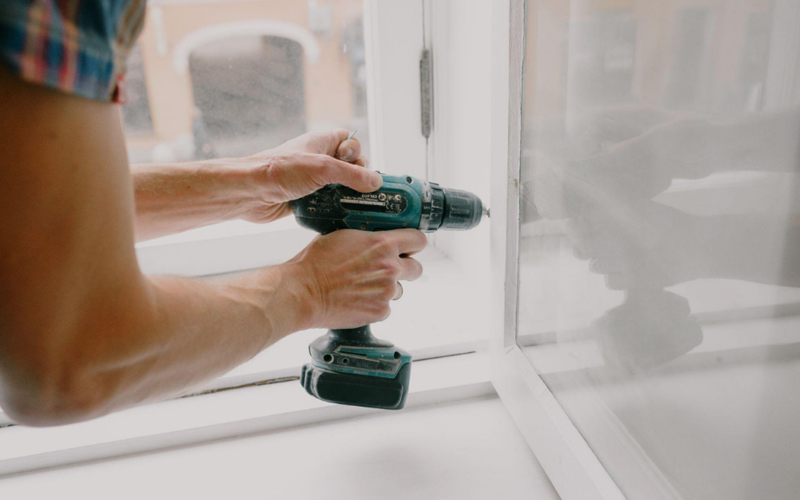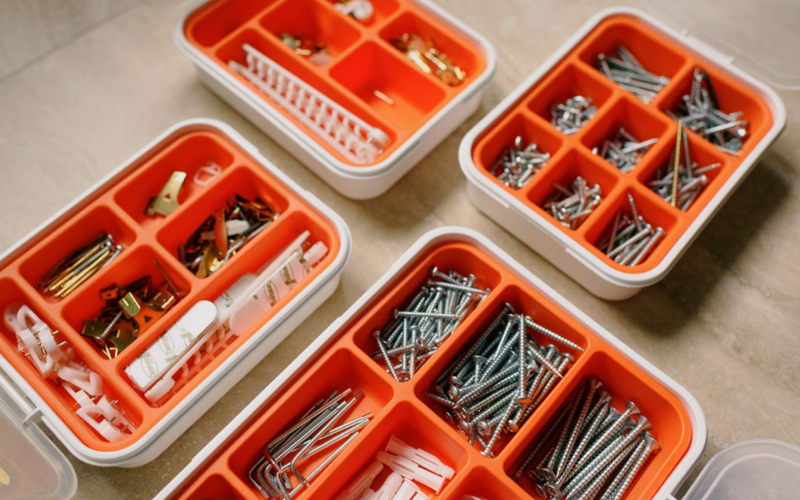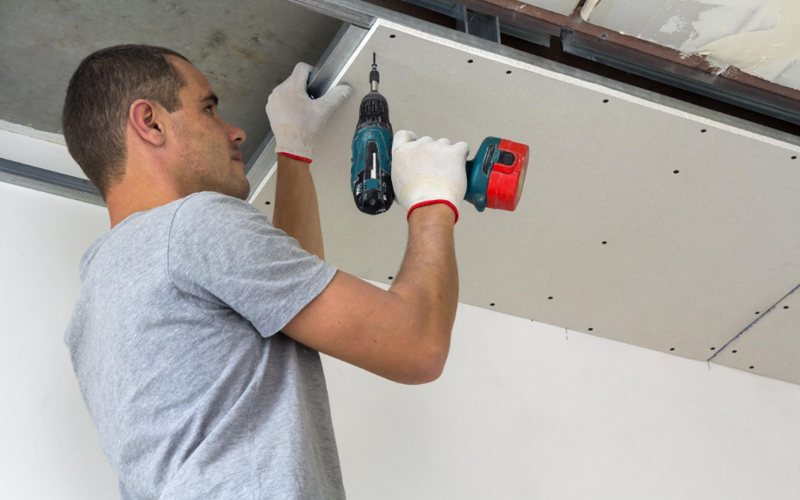The drywall is kept firmly attached to the wall studs by using the right screw placement and spacing, which also prevents sagging or separation over time.
Although it may not seem like a complicated subject, perspectives might differ, and for a project to be successful, it is imperative to be well-informed.
The standard recommendation is to insert drywall screws every 12 inches.
When the sheets are hung perpendicular to the framing, this normally translates to around 32 screws for a 4-foot by 8-foot sheet, with five screws on each stud.

Depending on the requirements of the project, some experts advise employing 28, 40, or even 48 screws. But for most projects, 32 screws tend to be the standard beginning point.
The appropriate screw pattern and spacing must be confirmed in accordance with the regulations of your local jurisdiction because local building codes can differ.
You may guarantee a sturdy and long-lasting installation by adhering to these recommendations and comprehending the significance of precise drywall screw placement.
Drywall Sheet Sizes
Drywall sheets come in various sizes to accommodate different construction and renovation projects.
The most common sizes are 4×8 feet and 4×12 feet, providing flexibility depending on wall size and room dimensions.
Smaller sheets, such as 4×6 feet, may be used for tighter spaces or repairs.
To better understand the appropriate drywall sheet size for your project, consider the following:
1. Standard size sheets (4×8 feet): The majority of home construction and restoration projects use this size. They are simple to work with and require the least amount of trimming to fit the size of the wall.
2. Long size sheets (4×12 feet):These sheets are intended for use in bigger spaces, in commercial settings, or to minimize the amount of wall seams. Due to their weight and size, the 4×12 foot sheets require more screws than usual and additional laborers to install them.
3. Custom size sheets: Uneven wall sizes can be accommodated by cutting drywall sheets, but installation may be more time- and labor-intensive. When deciding between regular, long, and custom-sized sheets, it’s important to balance the benefits and drawbacks. Custom size sheets could result in higher labor costs and more waste.

The requirements of the particular project, the manpower available to install the sheets, and any applicable local construction codes must all be taken into account when choosing a drywall sheet size.
Remember that the size of the drywall sheets and the manner of installation will determine how many screws are needed.
Drywall Screw Length and Type
For attaching drywall panels to the framing, special drywall screws are used.
Different types and lengths are offered, each suitable for particular drywall thicknesses and uses.
Knowing the right screw length and type is crucial for a secure installation and a polished appearance.
There are two main types of drywall screws to choose from: coarse-thread and fine-thread.
Coarse-thread screws work better for connecting drywall to wood studs than fine-thread screws do for attaching drywall to metal studs.
It is essential to select the suitable thread type for proper installation and holding power.
The thickness of the drywall being installed determines the length of the drywall screws.
Here is a common rule for choosing the right screw length based on the thickness of the drywall:
●1/4-inch to 3/8-inch drywall: 1 1/4-inch screws
●1/2-inch drywall: 1 1/4-inch to 1 5/8-inch screws
●5/8-inch drywall: 1 5/8-inch to 2-inch screws
It’s essential to choose the correct screw length to ensure a strong connection between the drywall panels and the studs, without over-penetrating the framing material or leaving the screws protruding from the drywall surface.
Over-penetrating may cause damage to the framing, while protruding screws can create an uneven finish that requires additional repair work.
Always consult the drywall manufacturer’s guidelines or local building codes for specific screw recommendations and installation requirements.
In some cases, additional or alternative fasteners may be needed, such as when dealing with fire-resistant drywall or soundproofing materials.
General Rule for Screw Spacing
To guarantee a good installation, it’s crucial to follow some fundamental recommendations when it comes to screw spacing for drywall.
Generally speaking, drywall screws need to be placed every 12 inches.
This contributes to stability and stops the panel from drooping or popping in the fasteners over time, for example.
The screws should be spaced no more than 16 inches apart for walls and no more than 12 inches apart for ceilings.
Additionally, it is advised that screws be kept at least 3/8 of an inch away from panel ends and edges.

Fotoğraftan Spruce
This avoids break-out, which can happen if screws are positioned too closely to the edge and the drywall breaks or cracks in some places.
There will normally be a total of roughly 28 screws required to install a 4-by-8-foot sheet of drywall. The number of screws rises to about 36 for longer sheets, such as 4-by-12-foot panels.
For best support and a uniform appearance, the screws must be evenly spaced.
Screws for Wall Installation
When it comes to the installation of drywall sheets onto wall framing, the number of screws needed for proper attachment is crucial.
In this section, we will discuss the recommended screw spacing and pattern for both vertical and horizontal installations.
Vertical Installation
It is often advised to use 28 screws per sheet of 4-foot by 8-foot drywall when installing it vertically.
Four screws, spaced roughly 16 inches apart, are used to hold the sheets in place along each stud according to this design.
It is important to start from the top and work your way down, ensuring that each screw is evenly spaced for optimal support.
Yatay Kurulum
A 4-foot by 8-foot drywall sheet normally needs roughly 32 screws for horizontal installs.
The suggested pattern calls for using six screws on each of the two sides and four screws on each of the five middle studs.
When the sheets are hung perpendicular to the framing, this results in a total of five screws in each stud, with two on the edges and three in the field.
Though local construction rules could differ, it is usually best to confirm the right screw pattern for your particular job before beginning.

Regardless of the installation technique, the following general screw spacing recommendations should be followed:
●Space screws about 12 inches apart
●Use one screw through the drywall in each stud
●Space screws about 16 inches along the length of each stud
By adhering to these guidelines and closely following the recommendations for both vertical and horizontal installations, you can ensure a secure and durable wall attachment for your drywall sheets.
Screws for Ceiling Installation
The choice and positioning of screws are crucial for achieving a solid and secure installation of drywall on a ceiling.
Successful wall installations come from using the right drywall screws and adhering to the suggested spacing guidelines.
When erecting ceilings, it is recommended to use drywall screws designed specifically for ceiling applications.
To provide the necessary strength and grip, these screws should be between 1-1/4 and 1-5/8 inches in length.

Before fastening the drywall sheets to the ceiling joists, begin by driving the screws into the corners of the sheets.
Continue by putting screws in every 12 inches along the sheets’ borders and in the middle. This guarantees a uniform and stable attachment to the ceiling joists.
Here is a general guide for screw placement on a ceiling:
●Start at the corners
●Place screws every 12 inches along the edges
●Place screws in the field at 12-inch intervals
Note that local building codes can vary, and it is essential to consult with your local jurisdiction for specific requirements related to the number and spacing of screws.
Adhering to these guidelines will ensure a safe and secure ceiling installation.
Screw Placement Tips
When installing drywall, proper screw placement is essential for a secure, professional result.
Consider the following tips to ensure your drywall sheets remain firmly attached to the framing members.
The correct number of screws must first be used for each sheet of drywall.
You will need about 32 screws for a 4-foot by 8-foot sheet, and you might need up to 36 screws for a 4-foot by 12-foot sheet.
Remember that these figures may change depending on the thickness of the drywall and regional building regulations.
Another important aspect of screw placement is spacing.
Attempt to space screws along the framing members at a distance of about 12 inches.
This guarantees even weight distribution and load support over the entire sheet.
When hanging drywall vertically, keep in mind to begin at the top and work your way down, spacing screws at a distance of about 16 inches.
Screws should be inserted at the ends of sheets where they butt up against framing members.
To make the process smoother, consider these additional tips:
●Pre-drill pilot holes in the drywall if you’re having trouble getting screws to go in straight or to avoid tearing the paper face.
●Use a drywall screw gun or a drill with a drywall screw setter bit to maintain consistent depth and prevent over-driving the screws.
●When joining two sheets together, stagger the seams to avoid creating long, continuous joints that can lead to cracking or separation.
By adhering to these screw placement tips, your drywall installation will yield a stable, professional, and visually appealing result.
Çözüm
Use the right amount of screws while installing drywall to provide a solid and long-lasting hold.
A 4-by-8 sheet of drywall normally needs 28 screws, but a 4-by-12 sheet typically needs 36 screws.
Screws typically need to be spaced 12 inches apart on ceilings and 16 inches apart on walls.
To avoid drywall damage or deterioration, it is essential to keep screws at least 3/8 of an inch away from the edges and corners of the panels.
MaxXT can provide professional drywall screw guns to meet your decoration requirements
Keep in mind that individual drywall brands may have their own recommendations, so it is always a good idea to consult the manufacturer’s instructions for any unique requirements.
